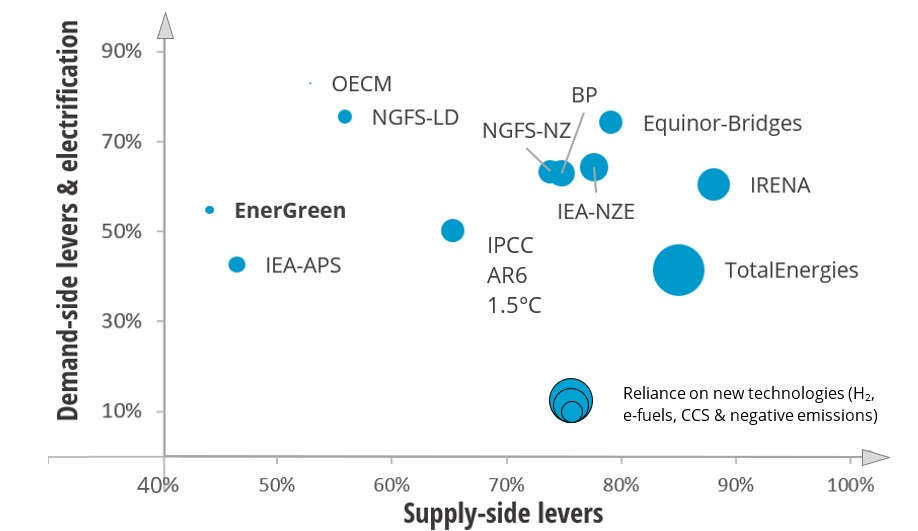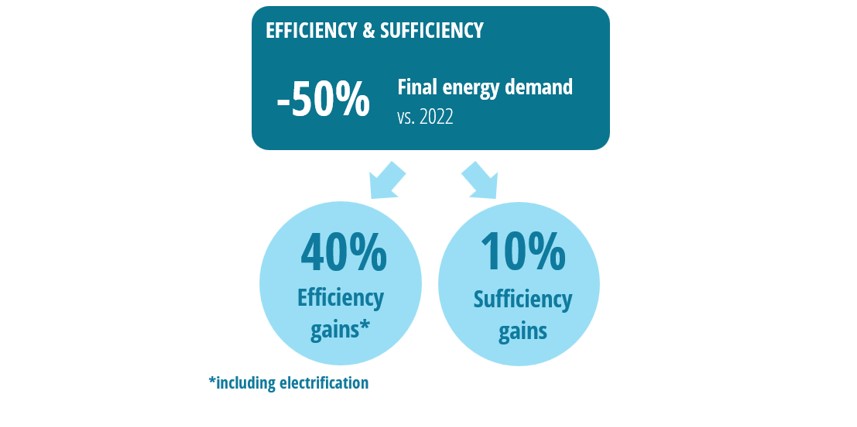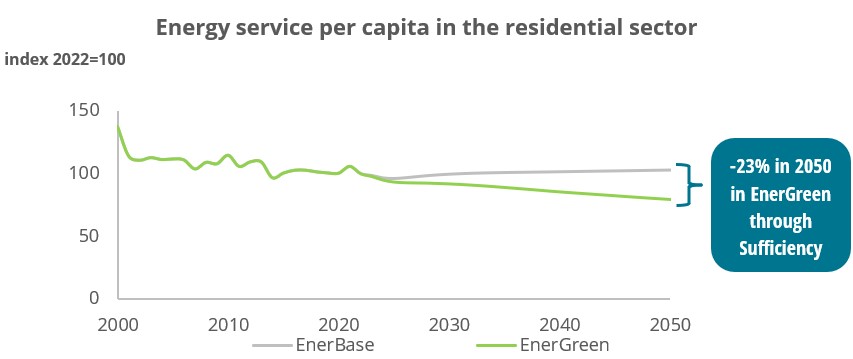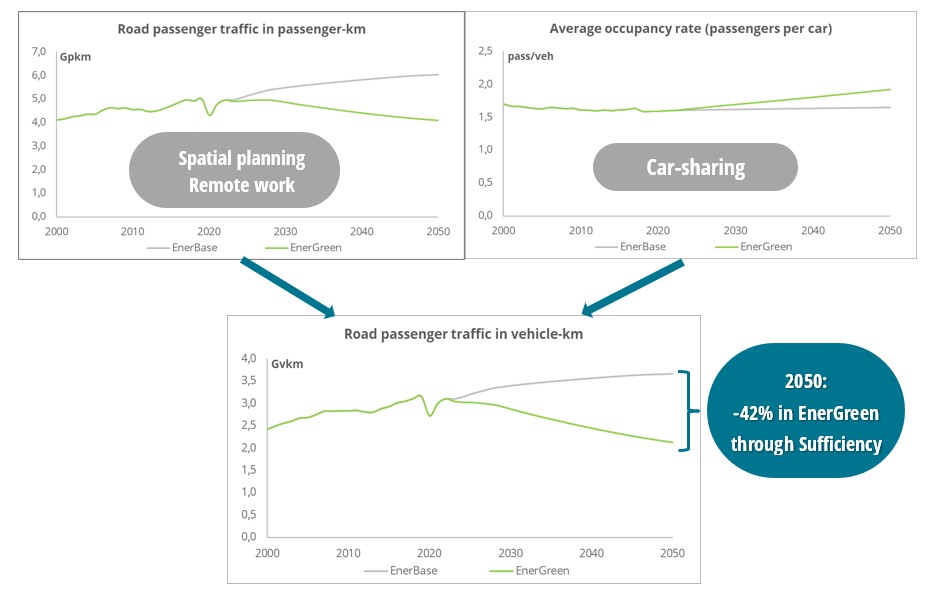See also
How to accelerate the EU energy transition: the power of sufficiency
In 2021, the energy sufficiency concept gained significant international recognition when the IPCC defined it, highlighting its importance through demand reduction.
Amid mounting pressures on resources, energy dependencies, and socio-economic challenges, why are strong sufficiency measures key to reducing energy demand and achieving carbon neutrality?

Energy Savings & Sufficiency
Move the individuals, the society and the economy towards the decarbonisation.
Sufficiency: The Missing Piece of the European Energy Puzzle?
Get this executive brief in pdf format (free)
In October 2024, the Journal, Nature Communications published an article called “The key role of sufficiency for low demand-based carbon neutrality and energy security across Europe” based on the “CLEVER” European energy scenario1. “The energy Sufficiency concept refers to reducing, in absolute terms where adequate, the consumption and production of end-use products and services through changes in social practices (supported by adequate infrastructures and frameworks), to remain within planetary boundaries while ensuring a decent social foundation for all people2”. While until now most energy scenarios have been focusing on technical strategies to achieve carbon neutrality, some scenarios start proposing new visions involving strong demand-side levers and in particular sufficiency strategies. These trajectories such as the CLEVER scenario, the Ademe Transitions 2050 scenarios or our EnerGreen scenario which limits global warming well below 2°C, envisage a strong focus on sufficiency options, expanding their scope beyond technological and supply-side levers to also address broader sustainability goals.
This brief explores the roles of energy sufficiency levers in long-term energy scenarios on the road to net-zero in Europe. It draws on recent energy scenarios, IPCC reports and on Enerdata’s EnerGreen pathway (the most ambitious of our three EnerFuture scenarios).
What is energy sufficiency?
As of today, only a minority of publications and policies consider sufficiency levers. Yet 2022 marked an important step with the definition and recognition by the IPCC of sufficiency as “a set of policy measures and daily practices that avoid demand for energy, materials, land, water and all natural resources while delivering human wellbeing3 for all within planetary boundaries” (IPCC, sixth Assessment report4). The IPCC engraves the sufficiency concept in the broader SER - Sufficiency, Efficiency, Renewables - framework, developed in the late 1990s by a French NGO (Negawatt 2017). The three pillars of the SER framework highlight the necessary complementarity between energy sufficiency and energy efficiency measures for achieving significant reductions in final energy demand along with the development of renewables on the supply-side. Approaches that focus solely on technologies risk overlooking planetary limits (pressure on raw and critical materials) and triggering rebound effects. Rebound effects occur when energy efficiency5 gains are partially or totally offset (by behavioural patterns). For example, in the car transport sector, efficiency gains linked to improvements in fuel consumptions (in L/km) since 1990 have been largely offset by an increase in the total distance travelled by cars and in vehicle weight6. Energy efficiency7 cannot be considered in isolation but should be complemented by energy sufficiency measures and a rapid transition to renewable energy in a scenario limiting global warming well below 2°C.
Sufficiency is not a new concept, its roots trace back to the Greek word sôphrosunè, which was translated into Latin as sobrietas, meaning ‘’enough’’8. After being largely supported by NGOs since the 2000s, the concept is now enshrined in the first Article of France’s 2015 Energy Transition Bill. Moreover, in 2022, amidst rising raw energy prices and increased European energy dependency9, the European Commission introduced the concept of “energy sufficiency” for the first time, in its RePowerEU plan in order to reduce its gas import dependencies. This recognition has completely changed the credibility of and interest in sufficiency measures in Europe, while it was only partially treated by a few countries before. However, the number of sufficiency measures taken by European countries in the context of energy crisis, remained short-term and focused on individual behaviour, whereas the sufficiency approach encompasses broader changes at societal level and require new infrastructures and norms to accompany the behavioural changes. To better understand the full scale of sufficiency measures and operationalise the concept, the négaWatt NGO proposes a fourfold categorisation of sufficiency dimensions:
- Dimensional sufficiency: adjusting the right size of an energy service to the right purpose (e.g., using vehicles appropriately sized and powered for the needs of travel)
- Cooperative sufficiency: maximising the sharing of energy services to reduce overall consumption (e.g., car-sharing, collective housing).
- Usage sufficiency: reducing the duration, intensity, or frequency of energy-intensive activities and optimising the lifespan of equipment (e.g., traveling less over long distances, lowering heating).
- Organisational/structural sufficiency: rationalising space consumption and organising spaces and human activities to minimise the need for transportation and resources (e.g., designing urban areas to reduce the distances required to access workplaces, shops, or public services).
Scenario benchmark: How do existing energy scenarios consider sufficiency indicators and levers?
Up to date, sufficiency does not play a major role in policy frameworks and in existing scenarios: technological levers are usually dominant, starting usually with renewables’ development and then energy efficiency solutions10.
A look at major world scenarios - from IEA, IRENA, IPCC, BP, TotalEnergies, NGFS11, OECM12 - shows that there is a lack of sufficiency indicators in the proposed approach towards decarbonisation (e.g., average floor area per person, average heating temperature, energy demand for domestic hot water, cooling, or cooking, car occupancy rate, aviation passenger kilometre). Little consideration is attributed to qualitative sufficiency measures such as new infrastructures and norms to accompany behavioural changes, or cross-sectoral sufficiency measures (life cycle assessment in buildings and industry sectors). Figure 1 categorises key global scenarios based on their reliance on "demand-side levers and electrification13” versus their use of "supply-side levers14" (development of renewables, H2 demand in 2050, fossil fuel captured emissions and negative emissions using BECCS in 2050). Larger blue dots in the figure represent higher levels of adoption of low-maturity technologies15 adoption. The majority of global energy scenarios rely more on supply-side levers (renewables, electrification, H2 production, fossil fuel emissions captured and negative emissions) rather than on demand-side levers and electrification, as shown by six scenarios on the right-hand side. Another observation is that the farther a scenario moves toward the lower-right corner of the graph, the larger its blue dot becomes, implying that a lower focus on demand-side levers is correlated to a higher use of non-mature technologies. The higher reliance on non-mature technologies introduces substantial risks and potential costs due to uncertainties in the feasibility, scalability, and economic viability of such technologies. Enerdata’s EnerGreen scenario show a minimal reliance on technological levers, paired with a medium level of demand side levers and electrification.
Figure 1: A comparison of global decarbonisation pathways: which reliance on new technologies across scenarios?

Source: Enerdata, Energy Climate Scenarios
Most scenarios do not include sufficiency indicators, but some of them, particularly the IPCC pathways, acknowledge the importance of behavioural and lifestyle changes as important mechanisms for demand reduction. According to the IPCC working group III, “having the right policies, infrastructure and technology in place to enable changes to our lifestyles and behaviour can result in a 40-70% reduction in greenhouse gas emissions by 2050”. Yet, some scenarios16 that prioritise reductions in energy demand, with varying geographical scopes can be identified17:
- World: Low Energy Demand (LED) for the Global North,
- World: NGFS Low Demand
- World, transports: SLOCAT Transport, Climate and Sustainability Global Status Report
- World: Schneider Electric - Back to 2050 (with higher reliance on energy efficiency levers)
- Europe: CLEVER, a Collaborative Low Energy Vision for the European Region,
- World and Europe: EnerGreen, EnerFuture’s Well below +2°C scenario.
- Transform scenario for the UK,
- négaWatt 2050 energy scenario for France, and Ademe Transitions Scenarios 2050
- Germany’s RESCUE GreenSupreme scenario
The above list of scenarios shows a significant range of potential reductions, converging around a 50% to 55% decrease in final energy consumption thanks to both efficiency and sufficiency levers. A common finding across these scenarios is that prioritising energy demand reduction enables achieving net zero emissions without dependence on low maturity technologies, such as CCS18. Other conclusions include the increased probability of reaching climate targets while significantly decreasing imports, lowering dependencies, risks and the externalisation of environmental and social damage and thus qualifies it as a “multi-solving strategy”.
What roles do strong sufficiency levers play in achieving a carbon-neutral Europe in EnerFuture?
Cross-sectoral: how much reduction could be achieved through sufficiency levers?
To explore the roles of strong sufficiency levers to reach net-zero emissions by 2050 in the EU, we take a closer look at Enerdata’s EnerFuture global scenarios19. The EnerFuture outlook includes three contrasted energy-climate scenarios up to 2050 for the global energy sector:
- EnerBase: continuation of existing policies and trends (temperature increase above 3°C).
- EnerBlue: Achievement of new NDCs submitted up to end of 2023 (between +2°C and +2.5°C).
- EnerGreen: Ambitious GHG emissions budget in line with the Paris Agreement (well below 2°C).
More particularly, we focus on EnerGreen scenario which envisages strong, yet realistic, sufficiency hypotheses and which aligns with the EU -55% emission reduction objective for 2030 (vs. 1990). EnerGreen integrates sufficiency indicators and behavioural changes across all end-uses sectors, combined with efficiency levers. In the case of EU-27, combining the two effects of energy efficiency and sufficiency allows a -50% reduction in final energy demand in 2050 (vs. 2022). On average, sufficiency levers account for 10% points of this reduction (figure 2) i.e. for one fifth of reduction.
However, in the building and transport sectors, sufficiency levers allow even greater energy demand reduction (see 3.B and 3.C), highlighting the indispensable role of sufficiency measures to reach EU climate emissions objectives.
Additionally, integrating sufficiency levers to the transition, delivers broader geopolitical and environmental benefits by lowering external dependencies, reducing of raw materials’ consumption in industry and buildings20, and diminishing water consumption.
Figure 2: Reduction of final energy demand in EnerGreen scenario for EU27 – A combination of Efficiency and Sufficiency Gains

Source: Enerdata, EnerFuture
Residential sector – sufficiency’s modelling and key levers
In the EU, buildings constitute the largest energy consumption sector, accounting for 36% of final energy consumption21. Thus, energy demand reduction in buildings is key to achieve EU objectives.
In EnerFuture, sufficiency and behavioural changes in buildings, and particularly in residential buildings, are modelled through a set of sufficiency indicators, notably:
- Space heating: the average energy service per square metre of dwelling (kWh/m2), impacted by behaviours (heating set point temperature) not by insulation nor efficiency
- Space cooling: the average energy service per square meter of dwellings equipped with AC (kWh/m2), and the diffusion of AC (share of dwellings equipped with AC units in %)
- Appliances and lightning: the average energy service per dwelling impacted by number of appliances and time of use (kWh/dwl),
- Cooking: the average energy service per person for cooking (kWh/cap)
- Water heating: the average energy service per person for water heating (kWh/cap)
Combining these indicators allows a total -23% reduction of final energy service per capita in EnerGreen compared to business-as-usual (EnerBase) in 2050 (figure 4). These quantitative indicators transcribe behavioural changes at individual level; however, these quantitative individual changes should be facilitated by collective enablers at political and institutional levels integrating equity principles22. For instance, ambitious renovation policies are essential to increase the isolation of dwellings and thus allow a reduction in the heating and cooling uses without compromising on individual comfort. Moreover, education, incentives and new norms are key to support behavioural changes: new regulations or revisions on current standards (Ecodesign Directive and the newly adopted Consumer Empowerment Directive23) on life duration at EU level, will help to decrease the average energy service of appliances.
Figure 3: Energy service per capita in the Residential sector for EU27 – EnerGreen vs BAU scenario

Source: Enerdata, EnerFuture / POLES model
Transports sector – sufficiency’s modelling and key levers
Transports sector is the second-largest energy consuming sector in the EU (30% of final consumption in 2023) and a highly emissive sector with a high reliance on oil products.
In a well-below 2°C scenario, combining a decrease in total distances travelled, together with important modal shift from the current predominance of private vehicles to low emitting public transports and active transports, is key to reach climate objectives and
broader environmental benefits. In EnerFuture, these structural and lifestyle changes are modelled, amongst others, by two indicators in road transports24: the total road passenger traffic in passenger-km and the car occupancy rates in passenger/vehicle. In EnerGreen, the decrease in total road passenger traffic – thanks to city-planning facilitating proximity to services, incentives for home working and sustainable leisure travels – combined with the increase in car occupancy rate, allow a -42% reduction of road traffic in vehicle-km in 2050 compared to BAU scenario (figure 4).
Besides these sufficiency levers, electrification of road transports will be key to reach emission targets. However, to avoid rebound effects, priority is given to small electric vehicles (over bigger EVs)25, thus allowing at the same time a reduction of material footprint and environmental impacts of lithium, cobalt and other critical materials.
Figure 4: Road passenger traffic in EU27 – EnerGreen vs BAU

Source: Enerdata, EnerFuture
Finally, sufficiency levers in road transports have positive impacts on final demand in the industry sector. Increasing occupancy rate of cars, reducing the size of new vehicles, including EVs, and increasing teleworking, enable to reduce material demand (steel and critical materials) in the industry.
Which impact on costs?
Research and current energy scenarios with a strong focus on sufficiency26 suggests that lower final demand achieved through sufficiency can limit the energy system costs of the transition to net-zero emissions.
At macroeconomic level, lower demand results in fewer residual emissions, meaning that expensive technologies such as carbon capture are not required. Additionally, strong sufficiency levers imply positive externalities (reduced air pollution, increased quality of food) allowing a reduction in public expenses27. In the transport sector, sufficiency levers such as developing car-sharing and remote work require less investments and R&D than technological levers (electrification of the fleet). However, they rely on developing new socio-cultural narratives and are thus more exposed to acceptation barriers. French négaWatt scenario also showed positive economic impacts of combining sufficiency, efficiency and renewable energies, thanks to new business models grow and alternative sectors boosted. Finally, in buildings according to IPCC, the SER framework reduces the cost of constructing and using buildings, without reducing the level of comfort of the occupant.
KEY TAKEAWAYS
- Strong sufficiency measures, alongside efficiency levers, are critical in reducing energy demand and achieving carbon neutrality in Europe.
The sufficiency concept has recently gained substantial recognition with two key publications: the European Commission’s REPower communication (2022), and the CLEVER scenario anchoring its transition on the Sufficiency, Efficiency, and Renewables (SER) framework (IPCC).
- Prioritising energy demand reduction and sufficiency levers reduces dependence on low maturity technologies (CCS), decreases geopolitical risks and socio-environmental damages.
Most global energy scenarios overlook sufficiency indicators and qualitative measures. However, some scenarios are beginning to prioritise energy demand reduction through sufficiency levers, facilitating reduced reliance on non-mature technologies, reducing imports and externalisation of environmental damages associated with resource extractions.
- EnerGreen introduces strong sufficiency hypotheses and sufficiency indicators, contributing to 1/5 of final energy demand reduction in 2050.
Enerdata’s EnerGreen scenario is an ambitious energy climate scenario for 2050, limiting global warming well below 2°C and compatible with EU targets. In some sectors, sufficiency levers together with efficiency measures enables even greater energy consumption reduction (-23% of final energy service per capita in 2050 in residential; -42% of total road passenger traffic in km-vehicle in road transports).
- Sufficiency levers transcribing individual behavioural changes must be facilitated by collective enablers at the societal level.
It is key to develop and integrate sufficiency indicators in energy modelling. However, these quantitative indicators transcribing individual changes need to be facilitated by collective enablers at society level (education, change of social norms) and at political and institutional levels (public infrastructures, incentives and regulations).
- Beyond energy modelling, identifying ongoing sufficiency initiatives and their outcomes is essential to bolster the credibility of scenario assumptions and narratives.
Notes:
- Using a bottom-up approach, the energy scenario demonstrates potential energy demand reductions of 52% by 2050 in comparison to 2020, via a combination of efficiency and sufficiency measures. This is achieved while increasing quality of life, thanks to the associated co-benefits in areas such as health, improved local environments, better work practices, reduced investment needs.
- Wiese, F., Taillard, N., Balembois, E. et al. The key role of sufficiency for low demand-based carbon neutrality and energy security across Europe. Nat Commun 15, 9043 (2024).
- Decent living standards are a set of essential material preconditions for human well-being which includes shelter, nutrition, basic amenities, health care, transportation, information, education, and public space (Rao and Baer 2012; Rao and Min 2018; Rao et al. 2019).
- 6th Assessment Report, Working group III, Chapter Building
- Energy efficiency aims at improving energy intensity
- For a complete analysis, see EEA - Fuel efficiency and fuel consumption in private cars, 1990–2011 and Cécile Hediger - The more kilometers, the merrier? The rebound effect and its welfare implications in private mobility (2023)
- Energy efficiency aims at improving energy intensity
- Cézard and Mourad 2019.
- IRIS, Revue internationale et stratégique, 2022/4 N° 128, Emmanuel Hache
- Wiese, F., et al. (2024). Little consideration is attributed to qualitative sufficiency measures such as new infrastructures and norms to accompany behavioural changes, or cross sectoral sufficiency measures (life cycle assessment in buildings and industry sectors).
- Network for Greening the Financial system -& NGFS Scenarios Portal
- OECM: One Earth Climate Model (UN)
- Demand-side levers (normalised index) include: Final energy consumption per capita in 2050 and Share of electricity in final energy
- Supply-side levers (normalised index) include: Renewables share in 2050 primary energy, Electricity share in final energy, H2 demand, Fossil fuel emissions captured in 2050 and Negative emissions.
- H2 demand and use of negative emissions through BECCS.
- That were not included in the graphical analysis
- Wiese, F., et al. (2024).
- Carbon, capture and storage (CCS)
- EnerFuture is relying on the recognised POLES-Enerdata model, an energy-economy-environment model of the global energy system, covering 66 countries and regions, with dedicating modelling of the individual end-use sectors, energy supply, prices and GHG emissions
- In the residential sector, slowing down the increase in individual floor space/person to keep it below a minimum decent living standard (30 sqm/person + 10sqm/additional person according to Rao and Minh), and prioritising deep renovation over new buildings, reduces demand for cement and steel in the industry sector.
- Including residential and tertiary sectors’ final energy consumptions (Enerdata, GED)
- Conseil économique social et environnemental (CESE), 2023 « What policies can support the transition of society toward sufficiency? »
- Consumer rights: final approval for the directive to empower consumers for the green transition - Consilium
- Other demand indicators exist for modal shift, rail and airplane travels, and for freight.
- Between 2012 and 2020, the average weight of new cars grew by 4% in the EU
- CLEVER, IPCC WKIII AR6’s Buildings Chapter, EnerFuture, Astérès study
- RTE 2022 (Réseau de Transport d'Electricité) Futurs Energétiques 2050 - Rapport Complet
 Energy and Climate Databases
Energy and Climate Databases Market Analysis
Market Analysis